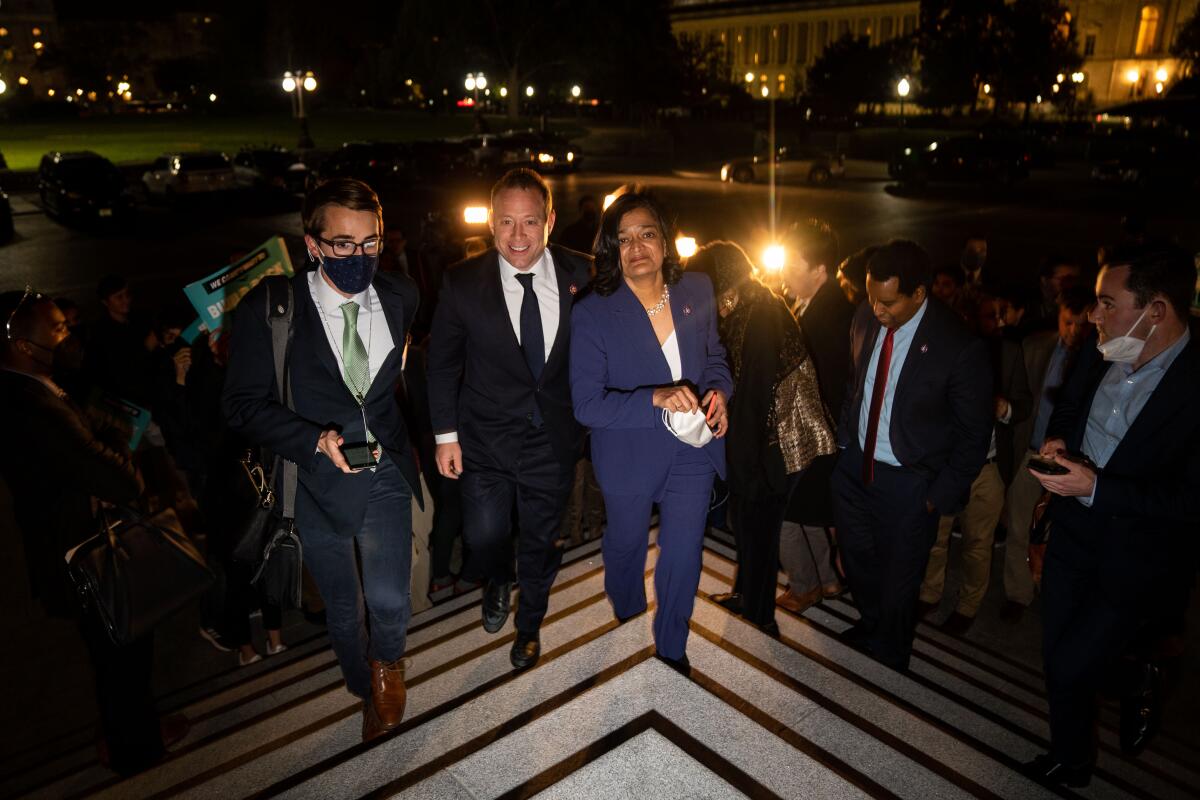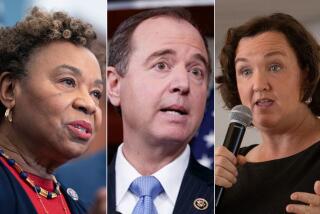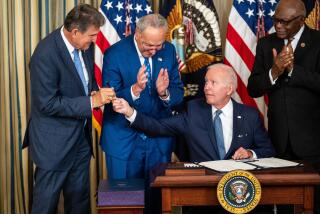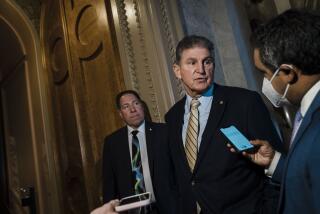Progressive Democrats test-drive new hardball tactics

- Share via
WASHINGTON — Progressive Democrats have never been shy about fighting for what they want.
But their aggressive tactics in the recent fight over a massive social safety-net package surprised many in their own party, raising questions about whether the tougher stance was an anomaly or a sign of battles to come.
Emboldened by Democrats’ narrow control of the House and Senate, the 95-member Congressional Progressive Caucus for nearly two months delayed passage of a bipartisan $1-trillion infrastructure bill — not because they opposed it, but to use as leverage in negotiations with moderates over a separate, larger spending package to address healthcare, childcare and climate change.
In the process, they repeatedly stalled President Biden’s legislative agenda and defied House Speaker Nancy Pelosi (D-San Francisco), who wanted to see the infrastructure bill pass in September.
This month, most progressives backed down and supported passage of the infrastructure bill, even though negotiations over the safety-net bill continue. Biden signed the infrastructure bill into law Monday.
But the unusually bitter battle illustrated both the rising power of progressives in the Democratic Party and their growing friction with moderates.
Some progressive lawmakers argued their hardball tactics were necessary to keep Biden’s legislative agenda on track, and ensure it did not fade away once the infrastructure bill passed. They view the fight as more of a one-time occurrence rather than a template for future negotiations.
“It’s a very unique situation,” Rep. Ruben Gallego (D-Ariz.) said in an interview. “I don’t think we’re going to be able to redo this.”
But progressive allies on the outside say they hope the caucus will continue to flex its muscle in ways it hasn’t in the past.
“I certainly think it can be sustained,” said Andrew O’Neill, senior economic justice policy manager at Indivisible Project. “This is much more analogous to a muscle that you work out and strengthen and then use more, rather than some sort of limited political capital that you just use and then it’s all gone.”
Joseph Geevarghese, executive director of the liberal outside group Our Revolution, said that progressives’ ability to hold together as a voting bloc for as long as they did was a signal to moderates that “there’s a new day in Washington,” with progressives emerging as a “much more powerful and assertive” group.
“We had to play legislative hardball to get taken seriously,” Geevarghese added. “It’s a numbers game, and we’ve got to elect more people who are willing to stand up. But look, I think there’s a playbook here that works and can work incredibly well if we have more progressive Democrats in the ranks.”
Moderates warn such a strategy may backfire for progressives, and the Democratic Party, in the long term.
Rep. Josh Harder (D-Turlock), a vulnerable moderate who represents a swing district, questioned the wisdom of opposing one bill to facilitate passage of a separate measure.
“I think that the best way, personally, to legislate is to vote based on the merits of the legislation that you have to consider,” he said. “And I think what frustrated me about the last fight is that I didn’t hear any folks that have a problem with the infrastructure bill that we helped put together. I don’t think it’s a strong legislative tactic to oppose one piece of legislation because you want something totally unrelated somewhere else.”
Many congressional Democrats expected progressives to fall in line much sooner than they did in the fight over the social safety-net package.
Progressive Caucus leaders said roughly half of their members were firmly opposed to a vote on the bipartisan infrastructure bill without legislative text on a broader social spending and climate change bill that could pass the chamber alongside the bipartisan measure, more than enough objections to sink the legislation on the floor.
Progressive Caucus Chair Pramila Jayapal said it was her members’ determination that made all the difference in standing up to pressure from party leaders and moderates.
“Most of our members have stayed with not getting out in front of the caucus,” Jayapal (D-Wash.) told CNN earlier this month. “It wasn’t like we just had a few people that weren’t going to vote for the infrastructure bill. We had between 30 and 60 members of our caucus who were not going to vote for the infrastructure bill alone. So my job is: When we say yes, we say yes. When we say no, we say no. And people should learn that — that I don’t say that unless I know I have the votes.”
By Nov. 5 — after the Congressional Black Caucus announced an agreement with leadership to hold a vote on the infrastructure bill and a procedural vote for the safety-net package, dubbed Build Back Better, later that day — progressives began to soften their position.
Rep. Katie Porter (D-Irvine), deputy chair of the Progressive Caucus, said the progressives’ strategy had run its course.
“We wanted the Senate to either pass Build Back Better first, then send it over to [the House], or at least agree that the Build Back Better Act the House passed would have their support when it got to the Senate,” Porter said. “And we held out for that, and we pushed for that and pushed for that. I think, ultimately, the judgment was that there was no more path to do that.”
Pressure from Democratic leaders was also building. Biden phoned into a Progressive Caucus meeting that afternoon and made the case that House Democrats needed to pass the bipartisan infrastructure bill that day, prompting a group of progressives — including Reps. Sara Jacobs (D-San Diego), Mondaire Jones (D-N.Y.), Ritchie Torres (D-N.Y.), Joe Neguse (D-Colo.), David Cicilline (D-R.I.), Jamie Raskin (D-Md.) and Debbie Dingell (D-Mich.) — to stand up and tell their colleagues that it was time to get to yes.
“Biden was absolutely critical,” said one member of the caucus who requested anonymity to speak candidly about the private meeting. “I think when the president called in, and when the president said, ‘Maybe we just can’t do any of this then,’ that’s, I think, when people were like hold on, no, we’ve got to get something done.”
Even so, in the end, six House progressives voted against the infrastructure bill, in part because the safety-net package had not been finalized. That would have been enough to block the infrastructure bill had 13 House Republicans not voted in favor of it.
Jayapal supported the Nov. 5. vote, but she led the push for progressives to resist compromises until the very end, according to the caucus member who requested anonymity. She initially rejected Biden’s Nov. 5 plea for unity. But as members’ stance began to weaken and “the tide started to turn,” according to the member, Jayapal cut a deal.
In return for progressives’ votes on infrastructure, moderates agreed to issue a general statement of support for the safety-net bill. The House is expected to pass a version of the safety-net bill this week and send it to the Senate, where changes are expected.
Some critics of progressives’ strategy compared it to actions more likely to come out of the GOP’s conservative House Freedom Caucus, whose disciplined members have never hesitated to obstruct or even topple Republican leaders who did not embrace their agenda.
Progressives reject such comparisons, saying that unlike many conservatives, liberals tend to believe in the power of government to bring about positive change, and that shared belief will prevent Democrats from fracturing as Republicans have.
“Here’s the thing about progressives: They actually care about people’s lives,” Rep. Jared Huffman (D-San Rafael) said. “And this [Build Back Better] bill has the promise of transforming people’s lives in a really good way, if we get it right. So that’s holding us together. That’s the glue.”
More to Read
Get the L.A. Times Politics newsletter
Deeply reported insights into legislation, politics and policy from Sacramento, Washington and beyond. In your inbox three times per week.
You may occasionally receive promotional content from the Los Angeles Times.











